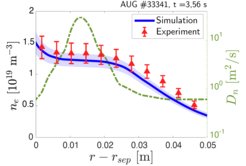Numerical Modelling of highly anomalous transport in the scrape-off layer plasma
An experimentally observed regime of enhanced turbulence-driven radial transport of plasma particles has been numerically simulated
Optimizing particle and power exhaust from fusion plasmas is mandatory in view of the design of future fusion devices, in order to avoid thermal overload and to reduce erosion on the plasma-facing materials.

Recently at the tokamak ASDEX Upgrade a regime of enhanced radial transport in the scrape-off layer (SOL) plasma has been observed, pointing to advective (i.e. not proportional to the density gradient) density transport. Realistic edge plasma simulations, performed with the SOLPS-ITER code, have shown that the transport coefficients required to reproduce the density profile have values larger than predicted by first-principle-based diffusion models. But they agree with a recently developed non-local transport model.
This work on the presence of enhanced transport has led to two important implications on power and particle exhaust physics. The achievement of partial divertor detachment, which is a desired divertor plasma regime, is facilitated and the power being transported into the far SOL leads to the re-ionization of neutrals recycling at the outer divertor target in the far SOL. This provides a possible explanation for the increased density observed in the mid-plane profiles in the far SOL, known as the “density shoulder”.
These findings help providing a basis for predicting the particle and power fluxes which must be sustained by the plasma-facing components in future fusion devices in realistic plasma scenarios.
This work has been recently published in A. Zito et al., Plasma Phys. Control. Fusion 63, 075003, 2021
